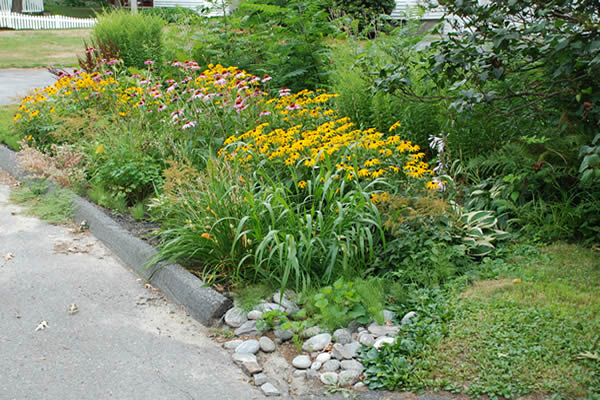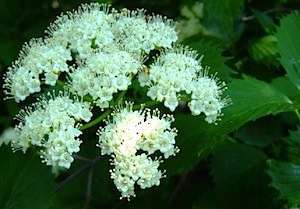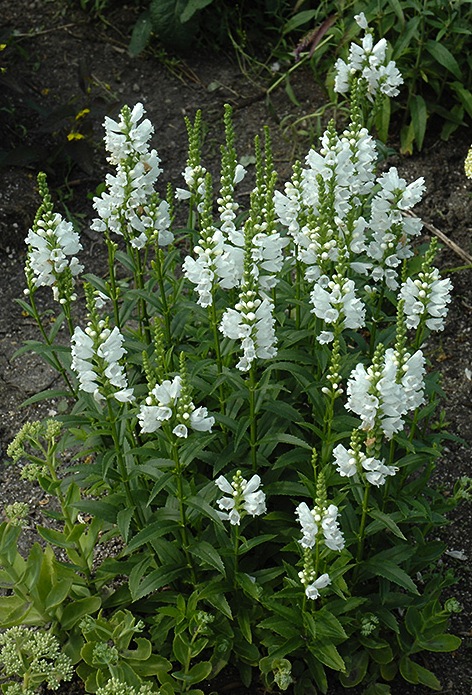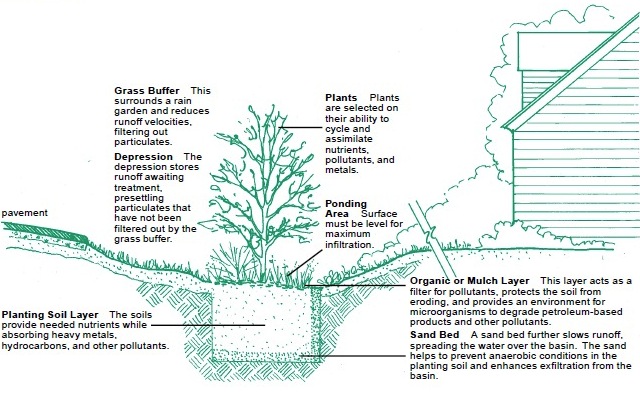Introducing the Pocket Rain Garden
By Elizabeth Cornell Fake, Fairfax Master Gardener
 In Virginia, we usually have our own rainy season in late May and early June. The rain water torrents down roofs and gutters, splashing off cement walks and driveways and winding its way down into the storm sewers. Environmentalists agree that the unfiltered, polluted water pouring off impervious surfaces is the major source of pollution for our nation’s waterways. A pocket rain garden is one way to manage our own home landscapes, by capturing and filtering the runoff that is so threatening to our rivers and oceans.
In Virginia, we usually have our own rainy season in late May and early June. The rain water torrents down roofs and gutters, splashing off cement walks and driveways and winding its way down into the storm sewers. Environmentalists agree that the unfiltered, polluted water pouring off impervious surfaces is the major source of pollution for our nation’s waterways. A pocket rain garden is one way to manage our own home landscapes, by capturing and filtering the runoff that is so threatening to our rivers and oceans.

Rain gardens can look attractive
Your lawn may be ideally suited for a pocket rain garden if, after a storm, there are areas of standing water in your landscape that may take two or more days to dry out. Often the water pours off the roof and gutters into a low-lying area of the lawn and sits there. Before long, the stagnant water will begin to attract mosquitoes. A well-positioned pocket rain garden will improve drainage in your yard, improve the quality of the underlying groundwater and reward you with a pleasant garden focal point.
As usual, adding this kind of landscape feature to your yard will take some study, planning and, of course, back-breaking labor. To start, there are five parts to a successful rain garden project that require investigation and planning in progression
- Part 1 — a ponding area or depression that will serve as the container for the runoff
- Part 2 — a soil bed at the bottom of the depression that permits good drainage and quality soil to nourish the vegetation
- Part 3 — a berm or barrier made of soil or rocks to slow the speed of the runoff and keep the water in the container
- Part 4 — a selection of native plants including perennials, shrubs or even a tree
- Part 5 — a thick layer of mulch to support the growth of the plants and retain moisture during periods of drought
Determining the location and the soil composition of the pocket rain garden are the two critical factors to insure success. Generally, it takes some detective work and observation to determine where exactly the runoff occurs and where the water travels during a storm. This will give you a good idea where to locate the garden. Then, as a matter of placement, you will want to conduct a “perc” or percolation test to see if the soil at the bottom of the selected site will drain efficiently. To test for soil drainage, dig a hole in the depressed area about 6 inches deep and about 12 inches in diameter. Then fill the hole with water and keep track of how long it takes for the water to be absorbed into the soil. If the water is still standing after twelve hours, this is a failure to “perc.” It doesn’t mean you won’t be able to locate the rain garden in the selected area, but if you are intent on the location, you will have to improve the drainage of the area, so the water passes through more rapidly. This also means you will need to do some soil testing to get a good idea of soil composition and its porosity and to find out if you need soil amendments.
For construction, measure about 10 feet from the foundation of your house and then, using a fluorescent spray paint, mark off a garden area that is perpendicular to the area of the runoff. The size of the garden is dependent on soil composition, since a more porous soil, such as a sand/silt mix, can be smaller because the water will pour through more quickly than a denser clay-mix soil. If the soil is compact and takes more time to drain, you will need a larger space to allow for proper drainage.
Before you lift a shovel to dig anything, be sure you have called Miss Utility to make sure there are no underground utilities at the selected garden site. Then call in a crew to help you dig the 6-inch-deep soil basin, create the berm and plant a selection of native perennials and shrubs. Suggested native plantings for our area of Northern Virginia include: Elderberry (Sambuca canadensis), Black chokecherry (Aronia melanocarpia), Winterberry holly (Ilex verticillata), Arrowwood viburnum (Viburnum dentatum), Virginia sweetspire (Itea virginica), Joe Pye weed (Eupatorium fistulosum), Switchgrass (Panicum virgatatum), Obedient plant (Physostegia virginiana) and Black-eyed susan (Rudbeckia hirta).
 Viburnum dentatum |
 Physostegia virginiana |
As a final step, cover the garden with a 3- to 4-inch carpet of double- or triple-shredded hard bark, cedar mulch. Be sure to allow open space around each plant for optimal watering. Water as required to establish the plants, and then let the rain take over the project. After all, it is a pocket rain garden!
Resources
• Clemson Extension Virtual Rain Garden, Clemson University Cooperative Extension Service,
Clemson University Center for Watershed Excellence
• Rain Gardens, Technical Guide 2014-5, State of Virginia, Department of Forestry
• Rain Garden Design and Construction — a Northern Virginia Homeowner’s Guide, Northern Virginia
Soil and Water Conservation District
… updated 2022
